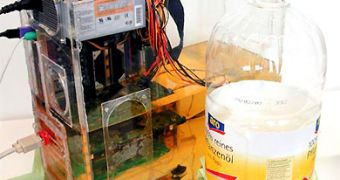Computer cooling solutions have been around ever since somebody realized that components behave better, last longer, go to higher frequencies when cooled down efficiently. First we have PC cooling in the form of air, water and refrigerator-based solutions, then there was the Thermal Electric Cooling (a.k.a. phase chance cooling) and even liquid nitrogen (LN2) cooling.
All of these solutions have different degrees of utilization, each user choosing what's right/suitable/appropriate/cool for him or her. When it came to the server segment, things got a little bit complicated; because of the amount of processing power needed for enterprise use, air cooling was the number one choice in most server systems, other solutions being considered a waste of time, energy and money. Only a little while ago some data centers had issues with air cooling, the problem being that in a limited amount of space, some companies had to overcrowd their facilities to suit their needs. That in term made the air conditioning systems become less than sufficient for the heat being produced.
So the solution of water-based cooling systems has come once again into the attention of systems administrators and it took the form of rack-level gear. This way, in the same amount of space, a system could be devised to effectively cool down the servers, without taking up significant extra space, and basically do the job it was supposed to do.
But there still is a little bit of a snag in these systems: they require a lot of energy, and they don't take the heat level down to a very low degree, but take it to a less "burning hot" level. That in term led to a search for more efficient solutions to cool down the servers, and soon something popped up. A while ago, the guys over at tomshardware.com made a test with another type of cooling, cooking oil. They made a computer air-tight see-through casing, and assemble a computer, placed it inside, and filled the case up with cooking oil, 8 gallons of it to be exact.
The results were surprising, to say the least, and seeing how desperate times call for desperate measures, a company called Very-PC has thought of a system that allows rack servers to be immersed in tanks filled with oil and a refrigerator added to the equation, which in term created a flow of currents, which drew heat away from the electronics. The temperature could be taken to -20 degrees Celsius, and future plans are already in place, the company hoping to have the first oil-bath server prototypes on the market for sale at the beginning of 2008.

 14 DAY TRIAL //
14 DAY TRIAL //